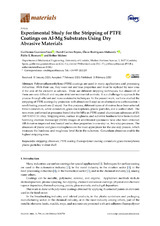Experimental Study for the Stripping of PTFE Coatings on Al-Mg Substrates Using Dry Abrasive Materials
Autor
Guerrero-Vaca, G.
Carrizo Tejero, David
Rodríguez-Alabanda, O.
Romero, Pablo E.
Molero, Esther
Editor
MDPIFecha
2020Materia
StrippingAbrasives
PTFE coating
Fluoropolymer coating
Corundum
Glass microspheres
Plastic particles
Walnut shell
METS:
Mostrar el registro METSPREMIS:
Mostrar el registro PREMISMetadatos
Mostrar el registro completo del ítemResumen
Polytetrafluoroethylene (PTFE) coatings are used in many applications and processing industries. With their use, they wear out and lose properties and must be replaced by new ones if the cost of the element so advises. There are different stripping techniques, but almost all of them are very difficult and require strict environmental controls. It is a challenge to approach the process through efficient and more sustainable techniques. In the present work, we have studied the stripping of PTFE coatings by projection with abrasives (1 step) as an alternative to carbonization + sandblasting procedures (2 steps). For this purpose, different types of abrasives have been selected: brown corundum, white corundum, glass microspheres, plastic particles, and a walnut shell. The tests were performed at pressures from 0.4 to 0.6 MPa on PTFE-coated aluminium substrates of EN AW-5182 H111 alloy. Stripping rates, surface roughness, and substrate hardness have been studied. Scanning electron microscopy (SEM) images of sandblasted specimens have also been obtained. All abrasives improved mechanical and surface properties in one-step vs. two-step processes. The abrasives of plastic and glass microspheres are the most appropriate for the one-step process, which increases the hardness and roughness level Ra in the substrate. Corundum abrasives enable the highest stripping rates.

